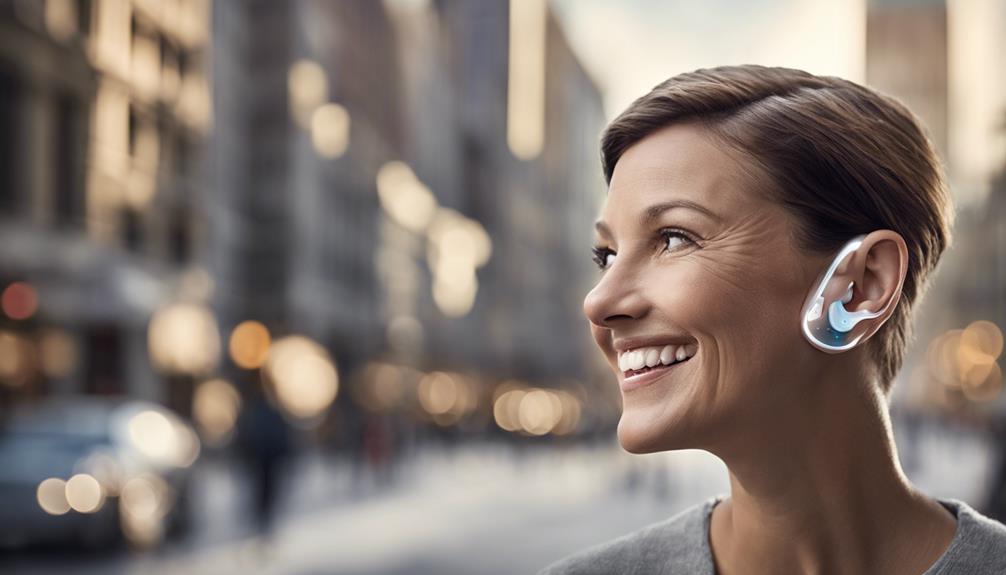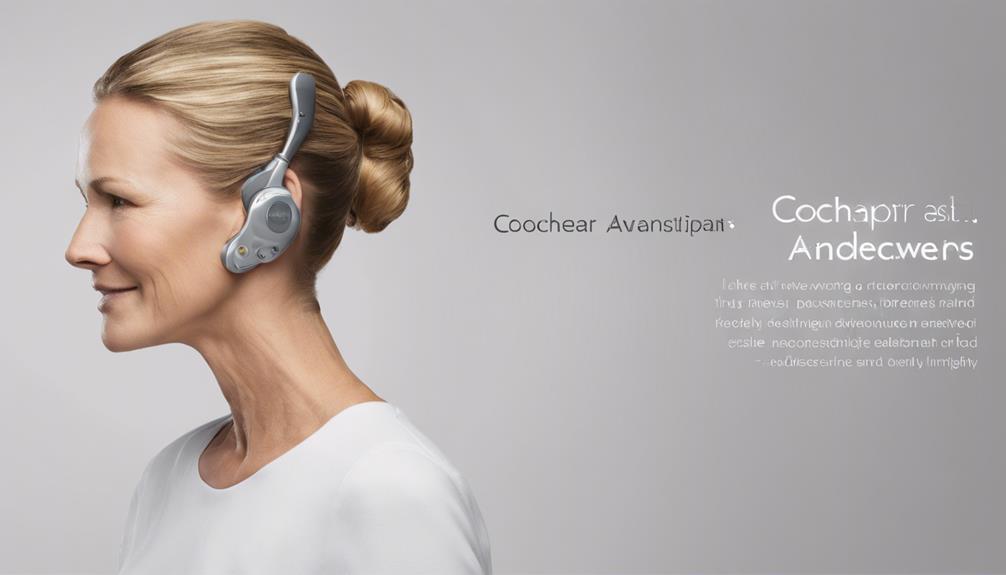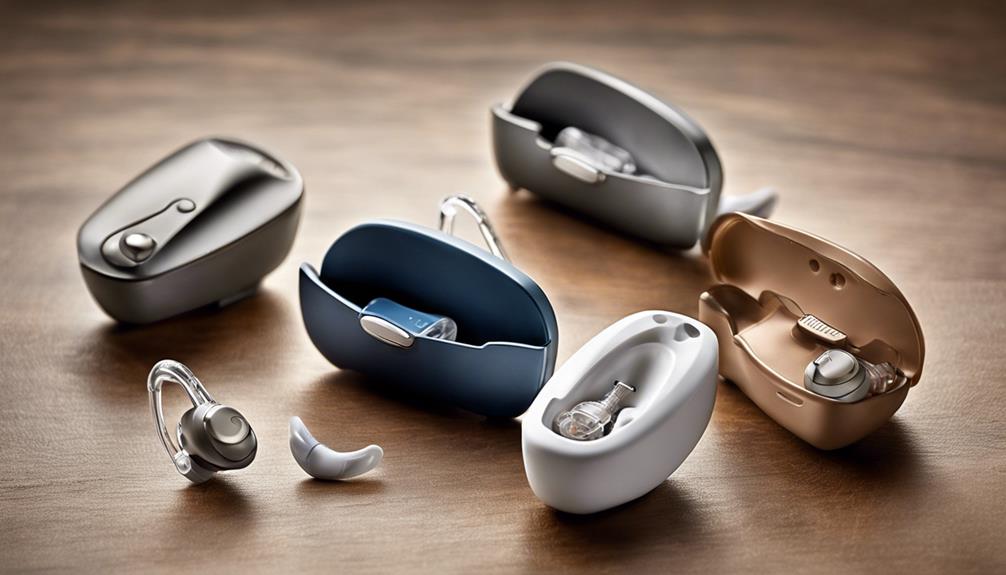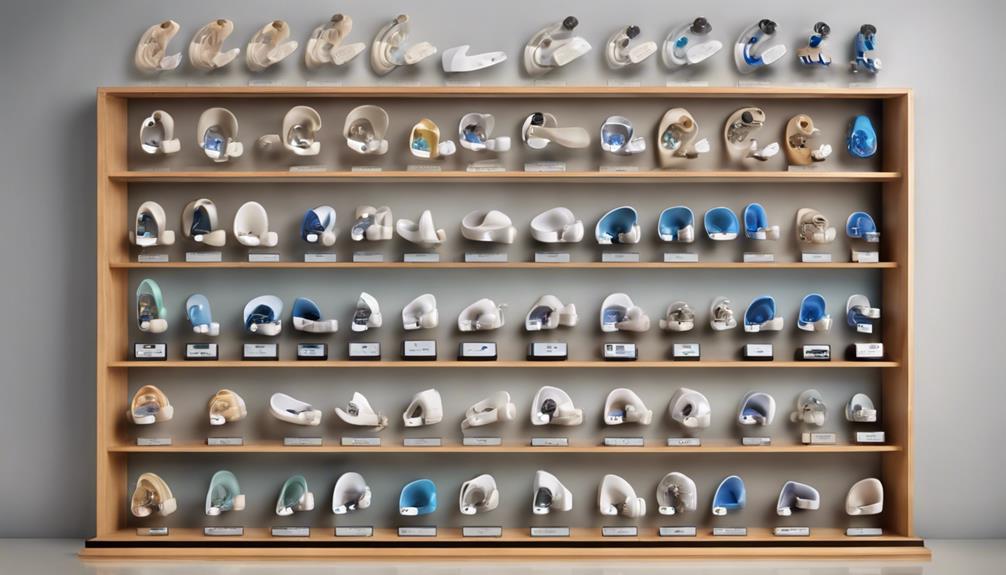Vision and Hearing Loss Support
What Does a Complete Hearing Evaluation Involve?
Embark on a journey to discover the harmony of life with Complete Hearing, where every whisper holds a key to unlocking a world of clarity and connection.

As we journey through the myriad of sounds that envelop us each day, the importance of attaining Total Hearing becomes clear. Every whisper, chuckle, or word of wisdom contributes to the music of living, and overlooking just one note can change the balance of our lives.
Understanding the intricacies of our auditory system and the ways to preserve its function is paramount in our quest for complete well-being. The journey toward optimal hearing health is not just about sound but touches upon various facets of our lives, promising a richer experience filled with clarity and connection.
Key Takeaways
- Regular hearing check-ups crucial for early detection and prevention.
- Communication strategies like eye contact and clear speech aid in conversations.
- Advances in hearing aids improve sound quality and comfort for users.
- Tinnitus management involves sound therapy, relaxation techniques, and CBT methods.
Understanding Hearing Loss Causes
Hearing loss causes stem from a variety of factors, including aging, exposure to loud noises, genetic predisposition, ototoxic medications, and specific medical conditions. The intricate mechanisms of the inner ear can be affected by these various causes, leading to difficulties in auditory perception.
Aging is a natural contributor to hearing loss, as the delicate structures within the ear may degenerate over time. Exposure to loud noises, especially over prolonged periods, can damage the sensitive hair cells responsible for translating sound vibrations into electrical signals. Genetic predisposition plays a role in certain individuals, making them more susceptible to hearing impairments. Ototoxic medications, which can harm the ear's sensory cells, pose another risk factor.
Moreover, infections, tumors, and blockages in the ear canal can also disrupt the auditory system, causing varying degrees of hearing loss. Identifying the specific cause through a comprehensive evaluation is crucial in formulating an effective treatment plan. By understanding the origins of hearing difficulties, tailored interventions can be implemented to address the root issues and improve overall hearing health.
Communication Strategies for Hearing Challenges

How can individuals with hearing challenges optimize their communication strategies for improved understanding and interaction?
When facing hearing challenges, it's crucial to implement effective communication strategies. Maintaining eye contact during conversations can enhance understanding by allowing individuals to read facial expressions and lip movements.
Incorporating visual aids such as written notes or gestures alongside verbal communication can provide additional context and clarity. Speaking clearly and at a moderate pace can help individuals with hearing difficulties follow conversations more easily.
Encouraging repeat-backs or summaries of important information ensures accurate understanding and reduces miscommunication. Furthermore, creating a quiet environment free of background noise is essential for individuals with hearing challenges to engage in effective communication.
Latest Advances in Hearing Aid Technology
Transitioning from communication strategies for hearing challenges, the latest advances in hearing aid technology introduce cutting-edge features aimed at enhancing sound quality and improving the overall listening experience for individuals with hearing loss.
These advancements encompass noise reduction capabilities that filter out unwanted background noise, ensuring clearer audio. Moreover, feedback reduction technology minimizes annoying whistling sounds that can occur with traditional hearing aids, enhancing comfort for users.
Speech enhancement features further optimize communication by emphasizing speech frequencies, making conversations more intelligible in various settings. Additionally, the programmability and wireless capabilities of modern hearing aids offer personalized settings and connectivity options for seamless integration into daily activities.
The continuous evolution of hearing aid technology not only prioritizes effectiveness but also emphasizes user comfort, ultimately enhancing the quality of life for individuals with hearing loss through these significant advancements.
Tips for Managing Tinnitus

With approximately 15% of the population affected by tinnitus, implementing sound therapy techniques such as white noise machines or nature sounds can significantly aid in managing the symptoms associated with this condition. These methods help mask the ringing or buzzing sounds, providing relief to individuals experiencing tinnitus.
Cognitive Behavioral Therapy (CBT) techniques have also shown effectiveness in reducing the distress caused by tinnitus. Avoiding exposure to loud noises and using ear protection can prevent tinnitus from worsening. Additionally, some individuals find relief through relaxation techniques such as yoga or meditation, which can help lower stress levels that may exacerbate tinnitus.
When sound therapy and relaxation techniques are combined, they offer a holistic approach to tinnitus management. It's essential for individuals dealing with tinnitus to explore these various strategies to determine what works best for them in alleviating the symptoms and improving their quality of life.
Importance of Regular Hearing Check-ups
Regular hearing check-ups are crucial for early detection and prevention of hearing loss. Routine assessments help individuals identify early signs of hearing loss and address changes promptly. Timely evaluations allow for prompt intervention and appropriate management of any hearing issues. Monitoring hearing health regularly ensures early detection and contributes to overall well-being. Professional tests at recommended intervals help identify concerns and ensure effective management. Being proactive about scheduling and attending check-ups is vital for safeguarding hearing health.
Addressing potential issues before they progress is key.
Frequently Asked Questions
What Is a Complete Hearing Test?
A complete hearing test involves a comprehensive evaluation of hearing function. This evaluation includes pure-tone audiometry to assess hearing sensitivity and speech testing to evaluate comprehension. Additional tests like tympanometry and otoacoustic emissions are also conducted to assess ear health. These evaluations help audiologists determine the type and severity of hearing loss for appropriate treatment recommendations.
What Are the 4 Types of Hearing Impairment?
There are four main types of hearing impairment: conductive, sensorineural, mixed, and central.
Conductive hearing loss stems from issues in the outer or middle ear, hindering sound conduction.
Sensorineural loss results from inner ear or nerve damage, impacting signal transmission to the brain.
Mixed loss involves a combination of conductive and sensorineural elements.
Central hearing loss arises from disruptions in the brain's auditory pathways, affecting sound processing despite normal ear function.
What Are the 5 Levels of Hearing Loss?
The 5 levels of hearing loss are categorized as normal, mild, moderate, severe, and profound based on the degree of impairment. Normal hearing ranges from 0-25 decibels, mild from 26-40 decibels, moderate from 41-55 decibels, severe from 56-70 decibels, and profound above 70 decibels.
Each level impacts an individual's ability to hear and understand speech, sounds, and environmental cues. Understanding these levels is crucial for diagnosis, treatment, and management strategies.
What Are the Three Types of Hearing Tests?
We can break down hearing tests into three main types: pure-tone testing, speech testing, and middle ear testing.
Pure-tone testing assesses hearing sensitivity by listening to tones at different frequencies.
Speech testing gauges the ability to hear and understand speech in various environments.
Middle ear testing examines the function of the middle ear components.
These tests help audiologists pinpoint the type and severity of hearing loss for tailored treatment strategies.
Conclusion
In conclusion, it's imperative to prioritize our hearing health to maintain effective communication and overall quality of life.
Did you know that approximately 1 in 6 adults in the United States experience some degree of hearing loss? This statistic highlights the prevalence of hearing challenges and underscores the importance of regular check-ups and seeking appropriate interventions to address hearing loss.
Take proactive steps towards optimal hearing health for a better tomorrow.
Albert brings a wealth of knowledge and expertise to our writing team. With a background in caregiving and a deep understanding of the challenges faced by caregivers, Albert’s writing resonates with authenticity and empathy. He is committed to delivering high-quality content that empowers and supports caregivers on their journey.
Vision and Hearing Loss Support
What Innovative Hearing Solutions Are Changing Lives?
Witness how innovative hearing solutions are revolutionizing lives, reshaping the way individuals interact with sound in extraordinary ways.

Although it might be thought that losing one’s hearing is a natural aspect of growing older, the truth is groundbreaking hearing aids are transforming lives in extraordinary ways.
From cutting-edge hearing aid technology to revolutionary cochlear implant advancements, the field of audiology is experiencing groundbreaking developments that are improving the lives of individuals with hearing impairments.
By exploring the latest advancements in speech-to-text glasses innovation, crowd noise filtering app development, and regenerative drug therapy breakthroughs, we uncover a world where technology is not just assisting but truly transforming the way people interact with sound.
Key Takeaways
- Bluetooth connectivity and AI in hearing aids enhance personalization.
- Cochlear implants offer direct audio streaming and advanced features.
- Speech-to-text glasses provide real-time subtitles and transcription software.
- Regenerative drug therapy shows promise in restoring damaged cells for hearing loss.
Cutting-Edge Hearing Aid Technology
As we delve into the realm of Cutting-Edge Hearing Aid Technology, we're introduced to a world where innovative advancements revolutionize the way individuals experience sound and enhance their quality of life. The line between hearing aids and cutting-edge technology has blurred, offering solutions that not only aid in hearing loss but also help people stay connected and engaged in various activities. With Bluetooth connectivity, these aids allow for direct audio streaming from digital devices, ensuring seamless integration into daily life. Features like GPS tracking not only prevent loss but also enhance usability, providing a sense of security for users.
Moreover, the incorporation of AI in hearing aids enables personalized adjustments, leading to optimal performance tailored to individual needs. This not only improves sound quality but also ensures comfort and effectiveness. Additionally, advancements in battery life offer all-day usage on a single charge, promoting convenience and uninterrupted support for those with hearing difficulties. The integration of health monitoring capabilities further contributes to overall well-being by tracking physical activity and cognitive health. Innovative hearing solutions are truly transforming the way we perceive and interact with the world around us.
Revolutionary Cochlear Implants Advancements

With wireless connectivity enhancing communication capabilities, cochlear implants have undergone revolutionary advancements in improving sound quality and connectivity for users. These advancements haven't only transformed the way individuals with hearing loss experience sound but have also opened up new possibilities for improved communication and accessibility.
Here are some key points highlighting the latest developments in cochlear implants:
- Direct Audio Streaming: Cochlear implants now support direct audio streaming, allowing users to seamlessly connect to various audio sources without the need for additional accessories.
- Bluetooth Technology: The integration of Bluetooth technology in cochlear implants reduces interference and ensures clearer sound quality, enhancing the overall listening experience.
- Advanced Features: Modern cochlear implants come equipped with advanced features that cater to different listening environments, providing users with greater comfort and convenience.
- Improved User Experience: These advancements in sound quality and connectivity not only enhance the user experience but also promote better integration with digital devices, making daily activities more accessible and enjoyable.
Speech-to-Text Glasses Innovation
Our exploration into innovative hearing solutions continues with a remarkable development in the realm of auditory assistance – the groundbreaking Speech-to-Text Glasses Innovation. Smart glasses embedded with real-time speech-to-subtitles technology leverage augmented reality to display subtitles directly on the lenses, revolutionizing communication for individuals with hearing loss. Vuzix has already introduced smart glasses equipped with transcription software, a step towards enhancing accessibility and inclusivity. In the next few years, we anticipate the widespread availability of affordable eyewear featuring automatic captions, further bridging the gap in effective communication. This innovative speech-to-subtitles technology represents a significant advancement in communication enhancement, offering a practical solution to improve interactions for those with hearing impairments. By integrating cutting-edge features into everyday eyewear, these smart glasses are paving the way for a more inclusive and connected world.
| Key Points | Description |
|---|---|
| Real-time subtitles | Augmented reality technology displaying subtitles on smart glasses |
| Transcription software | Vuzix smart glasses incorporating software for individuals with hearing loss |
| Automatic captions | Future affordable eyewear expected to have automatic captioning features |
| Communication enhancement | Speech-to-subtitles technology providing innovative solutions for hearing loss |
Crowd Noise Filtering App Development

Developers are creating a Crowd Noise Filtering App to enhance the listening experience of individuals with hearing impairments by isolating speech in crowded environments using AI technology. This innovative app employs de-noising algorithms to improve conversation understanding in noisy settings. Anticipated advancements in powerful de-noising programs within hearing technology over the next five years signal a promising future for communication enhancement in challenging auditory environments. By focusing on technologies that prioritize speech clarity and comprehension for hearing-impaired individuals, this app aims to revolutionize how individuals with hearing loss experience and engage in conversations in noisy situations.
- App for isolating speech in crowded environments uses AI to enhance listening experience for hearing-impaired individuals.
- De-noising algorithms within the app improve conversation understanding in noisy settings.
- Anticipated availability of powerful de-noising programs in hearing technology within the next 5 years.
- Focus on developing technologies that enhance communication in challenging auditory environments.
Regenerative Drug Therapy Breakthroughs
Through regenerative drug therapy breakthroughs, researchers have successfully activated chemical switches to restore damaged cells responsible for hearing, offering hope for individuals affected by various forms of hearing impairments. The potential of regrowing cells that help in hearing holds promise for restoring hearing lost due to damaged hair cells, especially in conditions like age-related hearing loss. Inspired by natural hair cell regrowth in animals like birds and fish, scientists are now focusing on developing hair cell regrowth therapies for humans, with ongoing clinical trials for hereditary or acquired hearing loss. These innovative approaches aim to provide permanent solutions for various hearing impairments by addressing the root cause of cell damage. Below is a table summarizing key aspects of regenerative drug therapy in the context of hearing loss:
| Regenerative Drug Therapy for Hearing Loss | |
|---|---|
| Focus | Restoring damaged cells responsible for hearing |
| Applications | Age-related hearing loss, hereditary/acquired hearing loss |
| Progress | Clinical trials ongoing for hair cell regrowth therapies |
Frequently Asked Questions
What Is the New Technology to Restore Hearing?
We've seen remarkable advances in technology for restoring hearing. Gene therapy replaces mutated genes with healthy ones, regenerative medicine regrows damaged sensory cells in the inner ear, and artificial intelligence in personalized hearing aids enhances sound quality.
Cochlear implants with wireless connectivity improve communication, and ongoing human trials for hair cell regrowth therapies offer hope for the future. These cutting-edge solutions are revolutionizing the way we address hearing loss and transforming lives.
What Innovative Technology or Surgeries Are Helping Our Deaf Patients?
We see the impact of innovative hearing solutions daily. From gene therapy to cochlear implants with Bluetooth connectivity, the advancements in technology and surgeries are truly transforming the lives of our deaf patients.
These cutting-edge options offer hope and improved quality of life. Our team is dedicated to exploring and implementing these groundbreaking techniques to help our patients hear the world in a whole new way.
What Is the Modern Treatment for Hearing Loss?
When it comes to modern treatment for hearing loss, advancements in regenerative medicine, gene therapy, and cochlear implants are revolutionizing the field. Drug therapies are being developed to regrow hearing cells, while clinical trials for hair cell regeneration offer hope for age-related or genetic hearing loss.
Gene therapy shows promise in addressing hereditary hearing impairments.
Advanced cochlear implants with wireless connectivity are enhancing communication and daily activities for users.
What Is the New Technology for the Deaf?
When it comes to new technology for the deaf, advancements are truly remarkable. From speech-to-subtitles in real-time to transcription software on smart glasses, the innovations are changing lives.
Imagine the possibilities of AI isolating speech in noisy environments for better listening experiences. With affordable eyewear featuring automatic captions on the horizon and powerful de-noising programs expected soon, the future looks bright for those with hearing challenges.
Conclusion
In this ever-evolving landscape of hearing solutions, we're witnessing a symphony of innovation harmonizing to create a crescendo of life-changing possibilities.
From cutting-edge hearing aids to revolutionary cochlear implants, the melody of advancements is bringing clarity and hope to those with hearing impairments.
With each breakthrough, we're composing a new era of sound, where individuals can once again experience the world in all its rich and vibrant tones.
Albert brings a wealth of knowledge and expertise to our writing team. With a background in caregiving and a deep understanding of the challenges faced by caregivers, Albert’s writing resonates with authenticity and empathy. He is committed to delivering high-quality content that empowers and supports caregivers on their journey.
Vision and Hearing Loss Support
Tell If Hearing Loss Is Permanent or Temporary: 5 Key Differences
Wondering how to distinguish between permanent and temporary hearing loss? Find out the key signs and factors that can help you determine the difference.

Recently, a pal shared they suffered from abrupt hearing impairment following a high-volume music event. This raised a question for us: how does one differentiate between lasting and short-lived hearing damage?
Understanding the nuances between these two types is essential, as it can impact the necessary steps for treatment and management. As we explore the signs and factors that differentiate temporary from permanent hearing loss, we aim to provide insights that could potentially help individuals navigate this aspect of their health more effectively.
Key Takeaways
- Differentiate between sensorineural and conductive causes for permanent or temporary hearing loss.
- Immediate evaluation is crucial for sudden hearing loss to determine permanency.
- Monitoring symptoms and audiometric tests help distinguish temporary from permanent hearing loss.
- Consult an audiologist for accurate diagnosis and tailored interventions for hearing loss.
Types of Hearing Loss
Exploring the various types of hearing loss provides crucial insights into the diverse mechanisms and conditions that can impact an individual's auditory function.
Sensorineural hearing loss involves damage to the nerves and hair cells responsible for transmitting signals from the inner ear to the brain, leading to difficulties in processing sound.
On the other hand, conductive hearing loss can occur due to obstructions such as ear infections, earwax buildup, or foreign objects in the ear canal, which hinder the conduction of sound waves.
Mixed hearing loss combines aspects of both sensorineural and conductive hearing loss, posing challenges in treatment planning.
Central hearing loss, affecting the central auditory nervous system, disrupts the brain's ability to interpret sound signals correctly.
Sudden hearing loss, characterized by a rapid decline in auditory function, necessitates immediate evaluation and intervention to prevent long-term complications.
Understanding these distinct types of hearing loss is essential in determining appropriate management strategies and providing effective support for individuals experiencing varying degrees of hearing impairment.
Causes of Temporary Hearing Loss

Temporary hearing loss can result from various causes such as ear infections, medications, allergies, loud noise trauma, and obstructions. When individuals experience temporary hearing loss, they may notice symptoms like muffled sounds, difficulty hearing high-pitched noises, balance issues, and tinnitus. This type of hearing loss can occur suddenly or develop over a short period, affecting people of all ages.
To determine the severity and type of temporary hearing loss, evaluation tests such as pure tone audiometry, tuning fork tests, and auditory brain stem response tests are commonly utilized.
The good news is that with appropriate treatment, temporary hearing loss can often be resolved. By addressing the underlying cause, whether it be treating an ear infection, adjusting medications, protecting the ears from loud noises, or removing obstructions, individuals can regain their normal hearing function. Seeking timely evaluation and intervention is crucial in managing temporary hearing loss effectively and preventing it from becoming permanent.
Causes of Permanent Hearing Loss
Permanent hearing loss can be caused by a variety of factors, including prolonged exposure to loud noise, age-related changes in the inner ear, certain health conditions, ototoxic medications, and gradual processes that necessitate early identification for appropriate management.
Prolonged exposure to loud noises can damage the delicate hair cells in the inner ear, leading to irreversible hearing loss. Age-related hearing loss, known as presbycusis, is a common cause of permanent hearing impairment due to natural changes in the inner ear over time. Additionally, certain health conditions such as genetic disorders, autoimmune diseases, Meniere's disease, viral infections, and head trauma can result in permanent hearing loss.
Furthermore, medications with ototoxic effects can contribute to irreversible damage to the hearing mechanism, leading to permanent hearing impairment. Recognizing the signs of these conditions early on is crucial for effective management and intervention to mitigate the progression of permanent hearing loss.
Distinguishing Permanent From Temporary Loss

When differentiating between hearing loss types, understanding the distinction between temporary and permanent conditions is crucial for effective management and intervention. Permanent hearing loss is typically irreversible, necessitating long-term treatment or management strategies.
Conversely, temporary hearing loss may resolve spontaneously or with appropriate treatment, such as addressing underlying causes like ear infections or earwax buildup. Audiological tests play a vital role in determining the type and severity of hearing loss, aiding in the differentiation between temporary and permanent conditions.
Monitoring the duration and progression of hearing loss symptoms can offer valuable insights into whether the loss is temporary or permanent. Seeking prompt evaluation by a healthcare professional is essential as it can lead to an accurate diagnosis and appropriate intervention for either temporary or permanent hearing loss.
Preventing and Treating Hearing Loss
Utilizing protective ear gear in noisy environments can significantly lower the risk of enduring hearing loss. Hearing loss can occur due to various factors, including exposure to loud noises and certain medical conditions. To address hearing loss effectively, it's crucial to take the best course of action promptly.
Here are four essential steps to prevent and treat hearing loss:
- Wear Ear Protection: Invest in quality earplugs or earmuffs to safeguard your hearing in loud settings, such as concerts or construction sites. Prioritizing ear protection can help prevent potential damage to your hearing.
- Seek Immediate Medical Attention: If you experience sudden hearing loss or notice a decline in your hearing abilities, see a doctor right away. Prompt evaluation can determine the causes of temporary hearing issues and guide appropriate treatment.
- Consult an Audiologist: Professional evaluation by an audiologist can accurately diagnose the nature of your hearing loss—whether it's permanent or temporary. They can recommend suitable interventions, such as hearing aids or cochlear implants, tailored to your specific needs.
- Follow Up Regularly: After initiating treatment, maintain regular follow-up appointments to monitor your hearing health. Tracking any changes in your hearing function can help manage hearing loss effectively and adjust interventions as needed.
Frequently Asked Questions
How Long Does It Take for Temporary Hearing Loss to Go Away?
Temporary hearing loss typically resolves in a few hours to a few days, depending on the underlying cause. Seeking prompt medical attention and treatment can help speed up the recovery process.
Monitoring symptoms and consulting a healthcare professional can provide a clearer timeline for the duration of temporary hearing loss. Remember, early intervention is key to addressing temporary hearing loss effectively.
What Is the Difference Between Permanent and Temporary Hearing Loss?
When it comes to hearing loss, understanding the difference between permanent and temporary conditions is crucial. Permanent hearing loss is irreversible and often requires ongoing management, like hearing aids.
Temporary hearing loss, on the other hand, can be resolved with appropriate treatment. Differentiating between the two involves assessing underlying causes and conducting diagnostic tests.
Timely intervention and professional evaluation play a key role in determining the nature of the hearing loss and implementing effective treatment strategies.
Can Hearing Loss Go Away on Its Own?
Absolutely, hearing loss can indeed go away on its own, depending on the underlying cause. Factors like ear infections, earwax buildup, or certain medications can trigger temporary hearing issues that may resolve spontaneously.
It's crucial to monitor symptoms closely and seek professional evaluation to determine the nature of the hearing loss. Quick action and proper care can make all the difference in whether our hearing loss is fleeting or lasting.
How Do You Regain Temporary Hearing Loss?
We can regain temporary hearing loss through various methods, including seeking medical evaluation for proper diagnosis and treatment. Depending on the cause, treatment options like medication for infections, earwax removal, or noise reduction strategies can aid in recovery.
Monitoring symptoms and prompt medical attention are crucial in regaining temporary hearing loss effectively and preventing complications. Professional guidance from an audiologist or ENT specialist can provide tailored solutions for individual cases of temporary hearing loss.
Conclusion
In conclusion, whether our hearing loss is temporary or permanent, seeking help from professionals is key. By understanding the causes, distinguishing between the types, and taking preventative measures, we can better manage our hearing health.
Remember, our ears are precious and deserve the best care possible. Let's listen closely to our bodies and take action when needed to ensure a sound future ahead.
Albert brings a wealth of knowledge and expertise to our writing team. With a background in caregiving and a deep understanding of the challenges faced by caregivers, Albert’s writing resonates with authenticity and empathy. He is committed to delivering high-quality content that empowers and supports caregivers on their journey.
Vision and Hearing Loss Support
What Hearing Aids Are Available in Livingston?
Navigate through the diverse range of hearing aids available in Livingston, each offering unique features to revolutionize your hearing – you won't want to miss out on these innovative options!

Were you aware that in Livingston, around 15% of individuals aged 18 and above experience difficulties with their hearing?
The prevalence of hearing difficulties in the area has sparked a growing interest in the various types of hearing aids available.
From discreet designs to cutting-edge technology, the options are diverse and cater to a wide range of needs.
Let’s explore the array of hearing aids waiting to enhance your hearing experience in Livingston.
Key Takeaways
- Livingston offers a variety of hearing aid styles, including IIC, CIC, ITC, ITE, and RIC.
- Features like noise reduction, Bluetooth, custom molding, and rechargeable batteries enhance listening experiences.
- Consider factors like degree of hearing loss, lifestyle, and technology when choosing a hearing aid.
- Professional providers in Livingston offer personalized solutions, accurate diagnoses, and tailored care for optimal hearing health.
Hearing Aid Styles Overview
In Livingston, we offer a comprehensive overview of various hearing aid styles to cater to diverse preferences and needs. Our goal is to provide solutions that enhance better hearing and improve the quality of life for our clients. The range of hearing aids available includes Invisible-in-Canal (IIC), Completely-in-Canal (CIC), In-the-Canal (ITC), In-the-Ear (ITE), and Receiver-in-Canal (RIC) styles. Each style incorporates advanced technology such as noise reduction, Bluetooth connectivity, custom molding, and rechargeable batteries to meet individual requirements effectively.
For those looking for a discreet option that fits snugly in the ear canal, the Invisible-in-Canal (IIC) style may be ideal. On the other hand, the Receiver-in-Canal (RIC) style offers a lightweight design and powerful listening experience. We understand the importance of offering a variety of hearing aid styles that prioritize comfort and personalized solutions, ensuring that our clients receive tailored recommendations from our experienced hearing professionals.
Pros and Cons of Different Models

Let’s delve into the advantages and disadvantages of the various hearing aid models available to help you make an informed decision.
Type of Hearing Pros Cons Invisible-in-Canal Snug fit, noise reduction, ideal for active lifestyle Limited power for severe hearing loss Completely-in-Canal Low-profile, external controls for easy adjustment Small size may be difficult to handle for some users In-the-Canal Custom molding, Bluetooth connectivity, rechargeable May be visible in the ear, susceptible to moisture damage In-the-Ear Full-shell design, long battery life Less discreet, may pick up wind noise Receiver-in-Canal Lightweight, comfortable, high-powered listening Requires more frequent maintenance, higher cost
When considering which model to choose, it’s essential to factor in your hearing needs, the latest updates in technology, sound quality, and the degree of hearing loss you are experiencing. Each type of hearing aid has its own set of advantages and disadvantages, so it’s crucial to weigh these factors against your preferences and lifestyle to find the best match for you.
Customizable Features for Hearing Aids
Exploring the customizable features of modern hearing aids reveals a range of advanced technologies designed to enhance the user experience and improve hearing capabilities.
Noise-canceling technology is a valuable feature that helps reduce background noise, making it easier to focus on conversations or specific sounds.
Many modern hearing aids offer automatic adjustment capabilities, which adapt settings based on the listening environment, ensuring optimal hearing in various situations.
For convenience and eco-friendliness, some hearing aids come equipped with rechargeable batteries, eliminating the need for frequent battery changes.
Bluetooth connectivity is another common feature, allowing seamless connection with mobile devices for streaming audio or making hands-free calls.
Advanced models may even incorporate artificial intelligence, enabling personalized and adaptive sound processing tailored to individual preferences and environments.
These customizable features collectively contribute to a more seamless and personalized hearing aid experience, catering to diverse user needs and preferences.
Choosing the Right Hearing Aid

When selecting the right hearing aid, it’s crucial to consider various factors such as the degree of hearing loss, required features, comfort level, lifestyle, and the type of hearing aid that best suits your needs. To ensure you make an informed decision, consult with our team of experts who can assess your specific requirements and recommend the most suitable solution.
When choosing a hearing aid, take into account the following:
- Evaluate the latest hearing aid technology available, including adjustable features and different types like In-the-Ear (ITE), Receiver-in-Canal (RIC), Completely-in-Canal (CIC), In-the-Canal (ITC), or Invisible-in-Canal (IIC), to find the best fit for your needs.
- Consider lifestyle considerations such as your daily activities and listening environments to determine the features needed for optimal performance and comfort throughout the day.
- Ensure a personalized fit and effective outcome by undergoing a comprehensive evaluation with a Doctor of Audiology, including Real Ear Verification, to guarantee the selected hearing aid meets your specific requirements.
Finding Hearing Aid Providers in Livingston
To explore the availability of hearing aid providers in Livingston, one can connect with trained hearing consultants at Livingston Hearing Aid. These professionals offer personalized solutions tailored to individual hearing needs. Whether you’re looking for specialists in audiology, ENT, or hearing aids in Livingston, they can provide accurate diagnoses and tailored care to address your specific requirements.
By contacting us, you can work together with these experts to determine the best course of action for your hearing health. If you know someone in Livingston who could benefit from hearing aid services, encourage them to seek help from these dedicated providers.
Access to modern hearing aid technology is readily available through Livingston Hearing Aid, ensuring that you receive the support and care needed for optimal hearing aid performance. Trust Livingston’s range of hearing aid services to help you hear clearly and improve your quality of life.
Frequently Asked Questions
What Is the Average Cost of a Good Set of Hearing Aids?
When considering the average cost of a good set of hearing aids, it’s important to note that prices can vary significantly based on factors like technology level, features, and brand. In Livingston, TX, these devices typically range from $1,000 to $4,000 per ear.
High-end models with advanced functionalities may lean towards the higher end of the price spectrum. Insurance coverage or financial aid programs can sometimes help offset these costs.
Where Is the Best Place to Get Hearing Aids?
When looking for the best place to get hearing aids, it’s vital to consider factors like expertise, technology, and ongoing support provided.
In Livingston, our trained hearing consultants offer personalized solutions tailored to unique needs.
With access to modern hearing aid technology and support from experts in audiology, ENT, or hearing aids, you can find innovative solutions like invisible options and advanced features for exceptional sound quality.
What Are the Top Five Rated Hearing Aids?
When it comes to the top five rated hearing aids, they offer advanced features like Bluetooth connectivity and noise-canceling technology. These highly rated devices provide a comfortable fit and customizable options for varying degrees of hearing loss.
Users of these aids have reported improved communication, emotional stability, and overall health benefits. They’re known for their realistic and genuine sound quality, enhancing the listening experience. Warranties and detailed manuals ensure longevity and proper functioning.
Who Is Number One in Hearing Aids?
Number one in hearing aids is Starkey, a leading provider in Livingston. They offer innovative solutions, including invisible hearing aids with advanced features like their Evolv AI model.
These devices provide exceptional sound quality and unique features such as activity tracking. Starkey focuses on smaller, comfortable options that deliver realistic, genuine sound quality.
Their commitment to advancing hearing science and technology has truly improved lives.
Conclusion
In conclusion, the diverse range of hearing aids available in Livingston offers something for everyone, from discreet invisible models to advanced technology like Evolv AI.
With the support of expert consultants and personalized solutions, individuals can experience exceptional sound quality and improved communication.
It’s like having a symphony of sound tailored just for you, harmonizing your world in perfect balance.
Albert brings a wealth of knowledge and expertise to our writing team. With a background in caregiving and a deep understanding of the challenges faced by caregivers, Albert’s writing resonates with authenticity and empathy. He is committed to delivering high-quality content that empowers and supports caregivers on their journey.
-

 Dementia Care2 weeks ago
Dementia Care2 weeks agoHow Gabapentin Affects Dementia: A Comprehensive Guide
-

 Dementia Care2 months ago
Dementia Care2 months agoUnderstanding the Stages of Vascular Dementia: A Visual Chart Guide
-

 Dementia Care2 weeks ago
Dementia Care2 weeks ago5 Things You Need to Know About Jack Nicholson’s Dementia
-

 Medication Management1 month ago
Medication Management1 month agoGabapentin Side Effects: Memory Loss Concerns?
-

 Dementia Care2 months ago
Dementia Care2 months agoUnderstanding Narcissism and Dementia: A How-To Guide
-

 Palliative Care for Parkinson's2 weeks ago
Palliative Care for Parkinson's2 weeks agoPalliative Care for Parkinson’s: A New Hope for Patients”
-

 Dementia Care2 weeks ago
Dementia Care2 weeks ago10 Engaging Dementia Games for Cognitive Stimulation
-

 Dementia Care2 months ago
Dementia Care2 months agoHow to Deal with a Parent’s Dementia: A Practical Guide

















